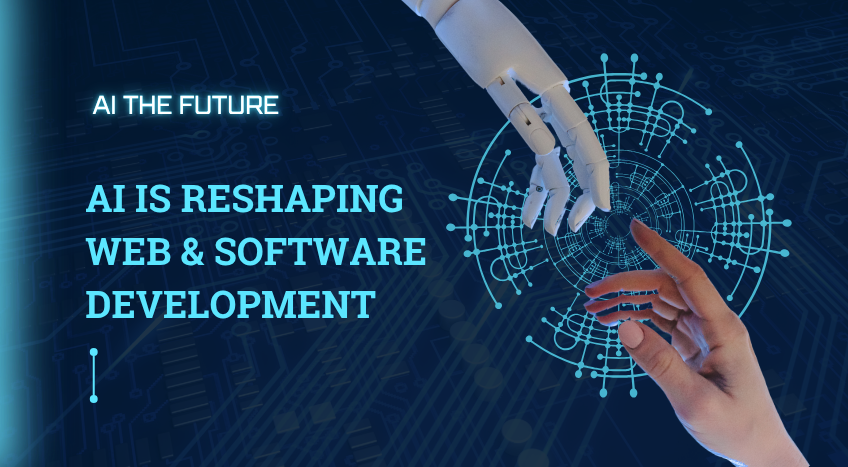
- Planning and Architecture: AI-Enhanced Ideation
Artificial Intelligence is no longer a futuristic buzzword—it’s the present reality transforming how web and software applications are built, tested, and maintained. From code autocompletion to AI-generated APIs, machine learning is weaving itself into every layer of the software development lifecycle (SDLC).
Whether you’re a solo developer, leading a startup, or overseeing enterprise-grade software as a CTO, it’s time to reimagine how development workflows function in the age of intelligent automation.
In this blog, we’ll explore how AI tools like GitHub Copilot, Tabnine, AI-based debugging assistants, and full-stack agents are revolutionizing the development pipeline—from planning and coding to testing, deployment, and personalization.
Planning and Architecture: AI-Enhanced Ideation
- Before the first line of code is written, project planning and system architecture are crucial. AI tools now assist in analyzing project requirements, automating documentation, and even generating architectural blueprints.
AI-Driven Requirement Analysis
Modern AI assistants can scan through historical user feedback, tickets, or product briefs to highlight features, define user stories, and auto-suggest requirement gaps. These insights drastically reduce miscommunication between stakeholders and developers, minimizing scope creep and rework.
Smarter Dependency Mapping
AI can visually map out system dependencies, detect bottlenecks, and identify redundant modules. These insights allow architects to design scalable and maintainable systems before a single deployment.
Code Generation: From Autocomplete to AI-Powered Development
- The most talked-about transformation in software development is AI’s ability to write code. Tools like GitHub Copilot and Tabnine are trained on billions of lines of public code, enabling them to predict and generate functions, methods, and sometimes even full modules.
GitHub Copilot and Tabnine in Action
These tools extend beyond simple autocompletion. Developers can now describe what they want a function to do in natural language, and the AI suggests working code snippets. This drastically reduces boilerplate writing and accelerates feature delivery.
Vibe Coding: Natural Language to Code
A new paradigm known as “vibe coding” is emerging, where developers communicate high-level functionality to AI using plain language, and the tool handles the underlying implementation. This not only increases speed but allows non-developers or junior engineers to experiment with ideas.
End-to-End AI Developers
AI agents like Devin are pushing boundaries even further—capable of taking on full-stack tasks, debugging themselves, documenting their work, and even integrating APIs. These AI models work alongside human developers as virtual team members, enabling faster delivery cycles and increased output quality.
Debugging and Testing: AI as Your Quality Guardian
- Finding and fixing bugs has traditionally been a time-consuming task. AI now plays a proactive role in catching bugs early and suggesting fixes on the fly.
Real-Time Bug Detection
AI-assisted IDEs can scan your codebase in real time, flagging logical errors, syntax anomalies, and security vulnerabilities. This allows developers to resolve issues before code ever reaches staging.
Automated Test Generation
AI tools can generate unit and integration tests based on function definitions or usage patterns. Instead of manually scripting test cases, developers can now rely on AI to ensure robust test coverage across their applications.
Smart Debugging
Code Review and Refactoring: Continuous Improvement with AI
- Modern development isn’t just about writing code—it’s about writing good code. AI-powered code review tools scan for inefficiencies, outdated practices, or inconsistencies with coding standards.
AI in Code Reviews
Instead of static linting, AI tools can evaluate code quality based on context. They flag poor naming conventions, overly complex functions, and even potential performance issues—providing actionable feedback to developers.
Refactoring Recommendations
AI suggests better alternatives for design patterns, highlights duplicated logic, and recommends restructuring code for better readability and maintainability. This helps reduce technical debt over time.
Deployment and CI/CD: Smarter Release Management
- As software development moves faster, so must deployment. AI now plays a significant role in orchestrating seamless and safe software releases.
Predictive CI/CD Workflows
AI-integrated CI/CD pipelines can analyze code changes to determine which test suites to run, prioritize critical paths, and decide the ideal deployment window based on usage analytics.
Auto-Rollback and Anomaly Detection
In case of a failed release, AI systems can predict rollback necessity based on anomaly detection—monitoring system performance, error logs, and user complaints in real time.
Intelligent Configuration Management
AI can dynamically adjust deployment settings based on traffic, device types, or user locations. This makes releases more adaptive and minimizes downtime.
API Generation and Integration: AI at the Backend
- Backend development is undergoing a silent revolution. AI now enables automatic generation of APIs, SDKs, and integrations.
Schema-to-API Conversion
By analyzing database schemas or user stories, AI can create full CRUD API endpoints complete with authentication, validation, and error handling. This allows frontend teams to begin working independently without waiting for backend development.
Intelligent Integration Mapping
AI matches fields between different systems during integrations—eliminating manual mapping tasks, reducing errors, and saving valuable engineering hours.
Smarter UX & UI Development: Personalization with Precision
- User experience is no longer static. AI is helping teams personalize web and app interfaces in real time based on user behavior, preferences, and goals.
Design-to-Code Automation
Tools now convert Figma designs or wireframes directly into production-ready HTML, CSS, and JavaScript code—saving hours of repetitive front-end work.
Dynamic UI Adaptation
AI monitors how users interact with your app and can alter layout elements, content suggestions, or call-to-action buttons on-the-fly for a more personalized experience.
Maintenance and Monitoring: AI for Long-Term Code Health
- Post-deployment, AI continues to provide value through monitoring, feedback loops, and ongoing maintenance recommendations.
Anomaly Detection in Production
AI monitors user logs, system metrics, and network traffic in real time to detect unusual patterns, performance drops, or potential breaches—often faster than traditional alert systems.
Technical Debt Tracking
AI tools track how code evolves over time and assess its maintainability, recommending refactors or decompositions for long-term health.
Documentation Automation
From generating API docs to updating changelogs and README files, AI keeps technical documentation in sync with the latest changes.
Strategic Benefits for Businesses & Teams
- The integration of AI into software development isn’t just a technical evolution—it’s a strategic advantage.
Faster Development Cycles
By automating repetitive tasks, companies can reduce time-to-market by 30–50%. This is crucial for startups competing in fast-paced markets.
Improved Code Quality
AI-led reviews, testing, and debugging result in fewer bugs in production, lower maintenance costs, and better user satisfaction.
Resource Optimization
Senior developers can focus on solving complex problems, while AI handles basic code writing, reviews, and testing—improving overall productivity and morale.
Key Challenges and Considerations
- Despite its many advantages, adopting AI in software development does come with risks and challenges.
Accuracy and Hallucinations
AI models can generate incorrect or insecure code. Human oversight is essential to validate outputs and maintain software integrity.
Over-reliance on Automation
Relying too much on AI can erode core programming skills. Developers must stay grounded in fundamental engineering principles.
Security and IP Concerns
The Future: Co-Creation, Not Replacement
- The evolution of AI in software development doesn’t signal the end of human developers—it signifies a new era of human-AI co-creation. Developers are becoming orchestrators, curators, and architects of intelligent systems, working alongside AI agents that handle the heavy lifting.
With the rise of full-stack AI agents, natural language development, and intelligent CI/CD, the software industry is witnessing a shift as profound as the invention of compilers or version control.
Conclusion
From code to intelligence, the transformation is already underway. AI is empowering software development to build smarter, faster, and more secure applications—redefining what’s possible in software engineering.
For developers, startups, and enterprise tech leaders, now is the time to embrace AI-driven tools, rethink workflows, and future-proof your development pipelines.
In this era, the best-performing teams won’t just write better code—they’ll collaborate with smarter machines to create world-class software experiences.

